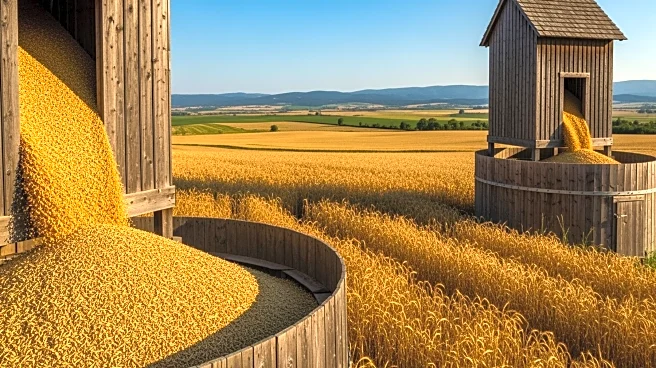What's Happening?
Farmers in the United States are facing significant challenges as they enter another harvest season with record grain production and limited storage capacity. According to the USDA's September World Agricultural
Supply and Demand Estimates (WASDE), corn production for the 2025/26 season is projected to reach a record 16.8 billion bushels, a substantial increase from the previous year's 14.87 billion. Despite a slight rise in exports, ending stocks are expected to remain high at approximately 2.1 billion bushels, which is contributing to low prices. Soybean production is also projected to increase to 4.3 billion bushels, although export demand has decreased by 20 million bushels due to global competition. The USDA's September Grain Stocks report indicates a decrease in corn stocks by 13% from 2024, while soybean stocks fell by 8%. Wheat stocks, however, have increased by 6% to 2.12 billion bushels. Despite the increase in production, total storage capacity has only grown by 0.1% in 2024, reaching 25.5 billion bushels, which is insufficient to meet the needs for all grain and carryover stocks.
Why It's Important?
The current situation poses significant economic challenges for U.S. farmers. The combination of record production and limited storage capacity is putting downward pressure on grain prices, which affects farm profitability. High transportation and energy costs further exacerbate the financial strain on farmers. The lack of adequate storage capacity, particularly in major Corn Belt states like Iowa and Illinois, leads to regional bottlenecks and congestion, especially with river transport delays. This situation highlights the need for improved infrastructure and storage solutions to support the agricultural sector. The pause in the October WASDE report due to federal budget uncertainty adds to the market's uncertainty during the peak harvest period, potentially impacting decision-making and financial planning for farmers.
What's Next?
Farmers will need to navigate the challenges of limited storage and low prices by optimizing space, timing, and liquidity to manage their harvest effectively. The agricultural industry may see increased advocacy for infrastructure improvements and policy changes to address storage and transportation issues. Stakeholders, including government agencies and agricultural organizations, may need to collaborate on solutions to enhance storage capacity and streamline transportation to alleviate the pressure on farmers. The situation also underscores the importance of monitoring global market trends and export opportunities to mitigate the impact of domestic challenges.
Beyond the Headlines
The current grain storage strain could have long-term implications for the U.S. agricultural sector. The need for investment in storage infrastructure and transportation networks is critical to support future growth and sustainability. Additionally, the situation may prompt discussions on policy reforms and incentives to encourage innovation and efficiency in grain storage and distribution. The challenges faced by farmers could also influence future agricultural practices and strategies, including crop diversification and risk management approaches.












